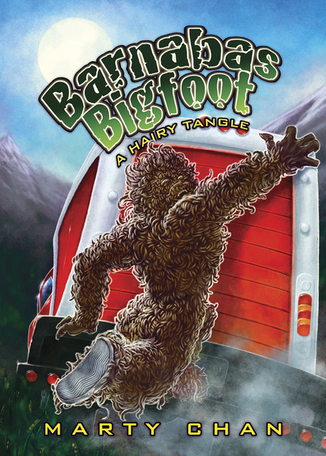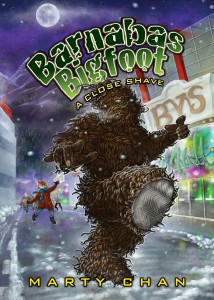Bigfoot tales make big impression on impressionable readers
Posted on December 12, 2012 By Mike Ross Features, Lit, The Latest
 Move over, vampires, or fly away, or whatever. “Sasquatch Chic” may be the next big trend in pop culture.
Move over, vampires, or fly away, or whatever. “Sasquatch Chic” may be the next big trend in pop culture.
A Pixar animated 3-D blockbuster would be a just reward for Edmonton writer Marty Chan, who releases “A Hairy Tangle,” the second rollicking adventure in his Barnabas Bigfoot series of young adult novels, this weekend. He’ll be at Audrey’s Books on Saturday at 3 p.m. to read and introduce the book’s “feature creature.”
Aimed at readers aged 8-10 but entertaining on any level, the new novel deals with a reclusive tribe of mountain yeti in their struggles to avoid the curious crypto-zoologists and the other human “baldfaces” that threaten their way of life, told through the trials of the young hero Barnabas. The reader should be easily hooked. One of several antagonists is a cowardly rival of the chief of the tribe, which happens to be Barnabas’s father, who is missing, presumed dead. The peril is almost constant, the action non-stop. It’s not hard to imagine it on the big screen.
The author has no trouble.
“All I’m doing is writing screenplays in book form,” Chan says. “I always think visually when I write, especially with kids’ fiction. There are so many kids who are reluctant readers, and part of the problem is the book is too hard for them to imagine what’s going on. I always think, how do I develop the story in a cinematic way that triggers their imagination so they can totally understand how the action is unfolding? And that usually carries them through the novel.”
From a playwriting and performing background, Chan has been focusing on his YA fiction writing almost exclusively for the last 10 years, along with teaching writing workshops for kids. It was at one such workshop four years ago where he got the idea for the Sasquatch world. The creature was picked at random from several student suggestions, and it just grew from there. Chan crafted a vivid backstory: Sasquatch, yeti, bigfoot, whatever they are called around the world, are real, and so is every other “legendary creature” you’d care to name. (He promises not to write about vampires.) They live apart from humans and prefer to keep it that way. They have their own lore, their own legends. Females of the species are generally stronger – and hairier – than males. They are as smart as the dirty, noisy, evil humans that search for evidence of the Bigfoot’s existence, and probably smarter, as all heroes in young adult fiction must be. The bad guys smoke cigars, but “as long as the good guys win most of the time, it’s OK,” Chan says.
 The story touches on number of themes: Culture, environmentalism, racism, isolation, alienation. Chan continues to be inspired by his own upbringing in Morinville, as “the only Chinese kid in a small town school,” which was the seed of the idea behind his CBC radio show “Dim Sum Diaries,” a series of semi-autobiographical mystery novels and his award-winning (adult) play, “Mom, Dad, I’m Living with a White Girl.”
The story touches on number of themes: Culture, environmentalism, racism, isolation, alienation. Chan continues to be inspired by his own upbringing in Morinville, as “the only Chinese kid in a small town school,” which was the seed of the idea behind his CBC radio show “Dim Sum Diaries,” a series of semi-autobiographical mystery novels and his award-winning (adult) play, “Mom, Dad, I’m Living with a White Girl.”
His lovable Sasquatches take it further. Chan spent a lot of the first Barnabas book, Close Shave, setting down the structure of his alternate universe in a story of the hero nearly being captured before being helped by a group of human children. Chan is planning to release the third novel in the series next year, and has already started working on a fourth. Given the number of plot twists and fresh legendary creatures introduced with each book, this saga could go on for a long time. “I’m going to try to string it out as long as I can,” Chan says.
He knows his target market well. The young adult fiction audience is more unforgiving and brutally critical than the most lettered literary critic at the New York Times. They want characters they can identify with and they want dramatic conflict – and they want it right soon, Chan says. Adults watching an adult play, he observes, will put up with just about anything for the first 10 minutes or so, only then demanding something in the story to make them care what happens next. “With kids there isn’t that same forgiveness zone: ‘I need it now or I’m moving somewhere else.’”
While the same basic rules apply to adult fiction in a less concentrated form, this is a “tricky” age to write for, Chan says. They still like “goofy” things – like a Bigfoot hero cursed with abnormally small feet – but also want some depth.
“My metaphor is that at that age, those kids are starting not to believe in Santa, but they still believe in the devil. So you have to play with this weird hybrid that they’re naive, but they’re trying to be worldly, so trying to find something that allows them to buy into your world is one of the biggest challenges.”
 It must get easier when lines between “adult” and “youth” literature are getting so blurred. Consider the popularity of Harry Potter books among grown-ups, not to mention the boom of comic cons and other forms of “geek culture.” The new Superchannel series Tiny Plastic Men is another good example – a children’s show that’s not suitable for children. Chan, age 47, says he collects far more comic books now than when he was a kid. His father didn’t do that sort of thing. So what’s going on?
It must get easier when lines between “adult” and “youth” literature are getting so blurred. Consider the popularity of Harry Potter books among grown-ups, not to mention the boom of comic cons and other forms of “geek culture.” The new Superchannel series Tiny Plastic Men is another good example – a children’s show that’s not suitable for children. Chan, age 47, says he collects far more comic books now than when he was a kid. His father didn’t do that sort of thing. So what’s going on?
“I think part of it is that sense of comfort of going back to the past,” Chan says. “You see retro fashion all the time, and there are a lot of options for people to go back to nostalgia. I guess people are longing for those days when they were cooler, younger, hipper.”













